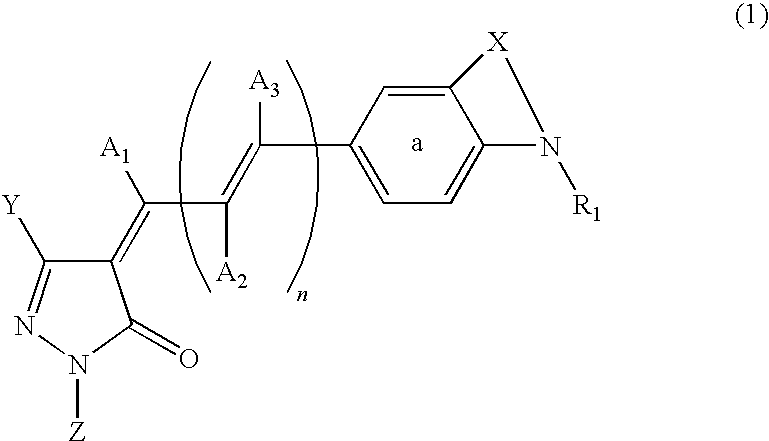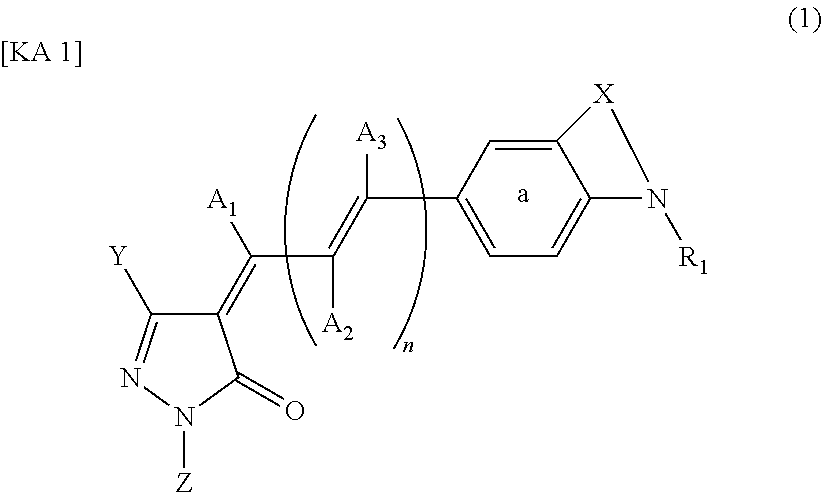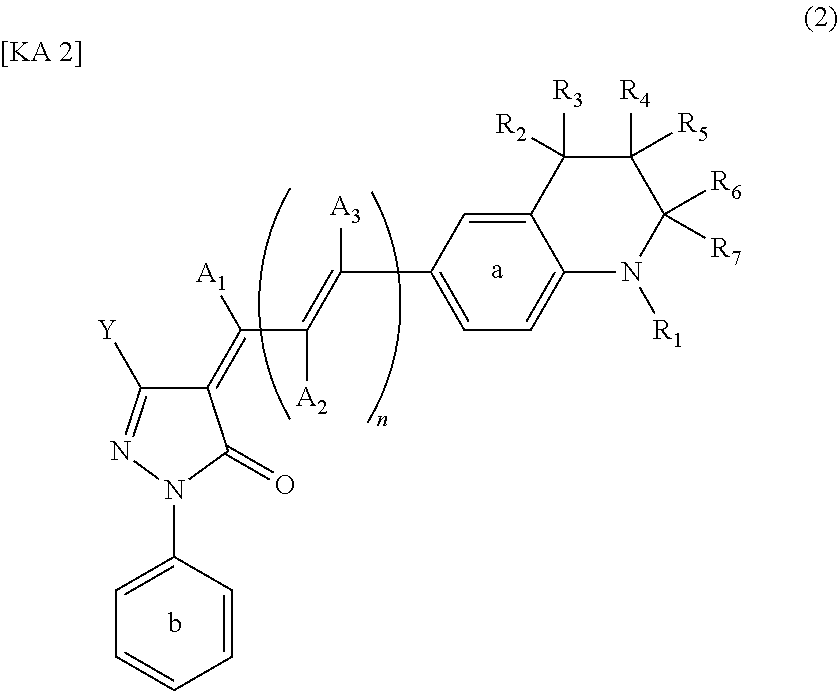Dye-sensitized photoelectric conversion device
a photoelectric conversion and organic dye technology, applied in the direction of methine/polymethine dyes, pv power plants, electrochemical generators, etc., can solve the problems of difficulty in widespread use, high cost of dye itself, and further problems in supply, so as to achieve high photoelectric conversion efficiency and improve the effect of photoelectric conversion efficiency
- Summary
- Abstract
- Description
- Claims
- Application Information
AI Technical Summary
Benefits of technology
Problems solved by technology
Method used
Image
Examples
example 1
[0109]Into 20 parts of ethanol were dissolved 1 part of the compound (300) illustrated below and 1.6 parts of the compound (301) illustrated below. To this solution was added 0.01 part of piperidine, and the resultant was heated and refluxed for 2 hours. After the reaction, the solution was cooled, and the precipitated crystal was separated and purified by column chromatography, and then recrystallized from ethanol to yield 1.2 parts of the compound (27). The maximum absorption wavelength and values measured by the nuclear magnetic resonance machine of this compound are as follows:
[0110]Maximum absorption wavelength: λmax=566 nm (water:acetonitrile=7:3)
[0111]Values measured by the nuclear magnetic resonance; 1H-NMR (PPM: d6-DMSO): 0.85 (t. 3H), 1.27 (m. 10H), 1.55 (m. 2H), 1.87 (m. 2H), 2.73 (m. 2H), 3.35 (m. 4H), 6.73 (d. 1H), 7.25 (m. 1H), 7.35 (d. 1H), 7.46 (m. 3H), 7.62 (d. 1H), 7.94 (m. 2H), 8.26 (m, 2H).
[0112]
[0113]Synthesis of Starting Compound (301)
[0114]Under the atmosphere...
example 2
[0115]The same process as in Example 1 was performed except that parts of the compound (301) were changed to 2.5 parts of the compound (302) illustrated below, so as to yield 0.9 part of the compound (3302).
[0116]Maximum absorption wavelength: λmax=526 nm (water:acetonitrile=7:3).
[0117]
[0118]Synthesis of Starting Compound (302)
[0119]The same process as in the synthesis of the compound (301) was performed except that 6.4 parts of 1-bromooctane were changed to 11 parts of 1-bromooctadecane, so as to yield 3 parts of the compound (302) as a yellow crystal.
example 3
[0120]The same process as in Example 1 was performed except that 1.6 parts of the compound (301) were changed to 1.5 parts of the compound (303) illustrated below, so as to yield 0.9 part of the compound (146).
[0121]
[0122]Maximum absorption wavelength: λmax=546 nm (water:acetonitrile=7:3)
[0123]Values measured by the nuclear magnetic resonance; 1H-NMR (PPM: d6-DMSO): 2.03 (m. 2H), 2.36 (s. 3H), 2.87 (m, 2H), 3.66 (m. 2H), 6.40 (d. 1H), 7.26 (m, 6H), 7.47 (m. 3H), 7.63 (d. 1H), 7.92 (m. 2H), 8.28 (m. 2H).
[0124]Synthesis of Starting Compound (303)
[0125]Under the atmosphere of nitrogen, 4 parts of 1,2,3,4-tetrahydroquinoline, 20 parts of 4-iodotoluene, 20 parts of dimethylformamide (DMF), 10 parts of potassium carbonate, and 1 part of copper powder (200 mesh) were stirred at 160° C. for 10 hours. After the reaction, the resultant was extracted with water / ethyl acetate, and the ethyl acetate phase was dried over magnesium sulfate. Ethyl acetate was distilled off, and the residue was sepa...
PUM
 Login to View More
Login to View More Abstract
Description
Claims
Application Information
 Login to View More
Login to View More - R&D
- Intellectual Property
- Life Sciences
- Materials
- Tech Scout
- Unparalleled Data Quality
- Higher Quality Content
- 60% Fewer Hallucinations
Browse by: Latest US Patents, China's latest patents, Technical Efficacy Thesaurus, Application Domain, Technology Topic, Popular Technical Reports.
© 2025 PatSnap. All rights reserved.Legal|Privacy policy|Modern Slavery Act Transparency Statement|Sitemap|About US| Contact US: help@patsnap.com



